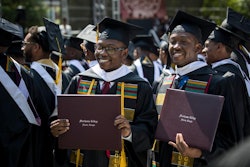Contemplating Brown: Conversations Across Generations
N.C. symposium draws over 400 to discuss landmark ruling
By Eleanor Lee Yates
DURHAM, N.C.
When noted historian Dr. John Hope Franklin looks back at the 50 years since the Brown v. Board of Education decision, he says he thinks of the heroism of the plaintiff parents along with their attorneys. Thurgood Marshall, counsel for the NAACP Legal Defense Fund, asked Franklin to help the lawyers with historical research.
Franklin, James B. Duke Professor Emeritus of History at Duke University, said he was “overwhelmed with joy” when he heard the news of the Supreme Court’s unanimous decision. “But I didn’t know it was going to be rejected by the larger community, that people would spit in the face of justice,” he said. “Where were the programs for desegregation? They moved at a deliberate speed or they didn’t move at all.”
Franklin shared his thoughts on Brown during a symposium commemorating the 50th anniversary of the Supreme Court decision. The event titled “Conversations Across Generations” drew approximately 450 educators, community and political leaders, and students to Hillside High School in Durham, N.C. Keynote speakers included Franklin; Elaine R. Jones, director-counsel of the NAACP Legal Defense and Educational Fund; and Dr. Julius Chambers, former chancellor of North Carolina Central University and former director counsel of the NAACP Legal Defense and Education Fund.
Franklin also shared some personal history with the symposium audience, including a car trip he took from the University of Wisconsin to Cornell University with his wife in 1953. He stopped at several motels, only to be told that the motel was full despite few cars in the parking lot. One desk clerk didn’t mince words, telling Franklin that she regretted that the motel did not take Negroes. The Franklins drove on to Canada, where they were able to get lodging.
“I remember thinking, what kind of country do I live in?” he said.
Throughout the one-day event, conversation sessions examined Brown’s effects today on the court system, politics, health care, business, community activism and religion. Participants viewed videos and exhibits that depicted events before and after the 1954 decision.
The conference was a collaborative event between North Carolina Central University, Duke University, North Carolina State University and the University of North Carolina at Chapel Hill.
During a discussion titled “Brown and the American Dream,” Steve Allred, executive associate provost at UNC-CH, recalled the experiences of the university’s first Black undergraduates, who enrolled in the fall of 1955.
“It was a terrible experience. They faced open hostility. None of them stayed,” he said. “We learn from the past. We hope there’s more to celebrate in the years to come.”
Today UNC’s enrollment is 11 percent Black with an overall one-fourth minority enrollment, he said.
Dr. William Chafe, dean of arts and sciences at Duke, noted the lack of national and statewide leadership in executing the Brown decision.
“President Eisenhower didn’t put himself behind the decision. (N.C.) Gov. Luther Hodges refused to provide support,” he said. The Greensboro school board voted to desegregate the day after the Brown decision, but it took three years before anything happened.
Chambers, a high-school student in rural Montgomery County at the time of the decision, recalled thinking his local school board would implement changes the next day.
“It was a long time coming, with broken hearts and frustration,” he recalled. Chambers later litigated the desegregation case of the Charlotte schools. But today he sees a dangerous trend of resegregation, of schools turning back the clock. He said he hoped others would now “pick up the mantle, as Thurgood Marshall did, to make sure all children enjoy equal educational opportunity.”
Like Chambers, Dr. Beverly Jones, dean of the University College at NCCU, is concerned about resegregation today, including at some magnet schools.
“The dream has not been realized,” she said, calling the achievement gap of Black children “a moral issue.”
In one small conversation group, “50 Years Later — Now What?” both White and Black participants talked candidly about race and contemporary concerns. Though segregation of schools is illegal, many aspects of life remain segregated.
A retired Black teacher said she had White friends but she felt “in my comfort zone when I’m with people like me.” One Black college student said her parents raised her in “a White world” until she insisted on going to NCCU to “find her culture.”
Discussion leader Carl Kinney, a local minister, talked of an underlying feeling by Blacks that “Black is inferior.” He spoke also of fragmentation within the Black community as many Blacks chase the upwardly mobile “White American dream.”
All agreed on the need for more diversity training in all aspects of life. Kinney challenged the participants to remember the struggles of past Civil Rights leaders.
“Did Martin Luther King work for a lie?” he asked.
© Copyright 2005 by DiverseEducation.com


















